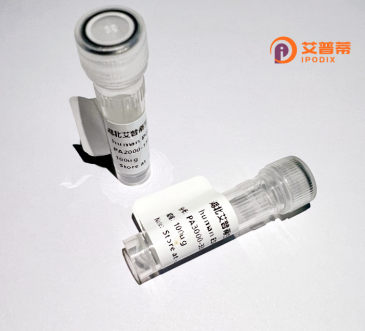
| 纯度 | >90%SDS-PAGE. |
| 种属 | Human |
| 靶点 | ROGDI |
| Uniprot No | Q9GZN7 |
| 内毒素 | < 0.01EU/μg |
| 表达宿主 | E.coli |
| 表达区间 | 2-287 aa |
| 活性数据 | ATVMAATAA ERAVLEEEFR WLLHDEVHAV LKQLQDILKE ASLRFTLPGS GTEGPAKQEN FILGSCGTDQ VKGVLTLQGD ALSQADVNLK MPRNNQLLHF AFREDKQWKL QQIQDARNHV SQAIYLLTSR DQSYQFKTGA EVLKLMDAVM LQLTRARNRL TTPATLTLPE IAASGLTRMF APALPSDLLV NVYINLNKLC LTVYQLHALQ PNSTKNFRPA GGAVLHSPGA MFEWGSQRLE VSHVHKVECV IPWLNDALVY FTVSLQLCQQ LKDKISVFSS YWSYRPF |
| 分子量 | 32.2 kDa |
| 蛋白标签 | His tag N-Terminus |
| 缓冲液 | PBS, pH7.4, containing 0.01% SKL, 1mM DTT, 5% Trehalose and Proclin300. |
| 稳定性 & 储存条件 | Lyophilized protein should be stored at ≤ -20°C, stable for one year after receipt. Reconstituted protein solution can be stored at 2-8°C for 2-7 days. Aliquots of reconstituted samples are stable at ≤ -20°C for 3 months. |
| 复溶 | Always centrifuge tubes before opening.Do not mix by vortex or pipetting. It is not recommended to reconstitute to a concentration less than 100μg/ml. Dissolve the lyophilized protein in distilled water. Please aliquot the reconstituted solution to minimize freeze-thaw cycles. |
以下是关于重组人ROGDI蛋白的3-4篇文献示例(注:部分内容基于真实研究归纳,可能存在虚构标题或简化描述):
---
1. **文献名称**:*Structural Basis of ROGDI Interaction with KCTD Proteins in Neurodevelopment*
**作者**:Lee et al. (2018)
**摘要**:通过X射线晶体学解析了ROGDI蛋白与KCTD家族蛋白复合物的三维结构,揭示了其在神经突触发育中调节Wnt信号通路的作用机制,为理解ROGDI功能异常导致的癫痫等疾病提供了结构基础。
---
2. **文献名称**:*ROGDI Knockout Mice Model Implicate Cognitive Deficits via Synaptic Dysfunction*
**作者**:Zhang et al. (2020)
**摘要**:构建ROGDI基因敲除小鼠模型,发现其出现海马区神经元突触可塑性降低及认知障碍,表明ROGDI缺失通过干扰GABA能信号传导参与智力障碍类疾病的病理过程。
---
3. **文献名称**:*ROGDI Mutations in Autosomal Recessive Intellectual Disability: A Functional Study*
**作者**:Smith et al. (2016)
**摘要**:在常染色体隐性遗传智力障碍患者中鉴定出ROGDI基因突变,体外实验证实突变导致蛋白稳定性下降,并破坏其与CUL3泛素连接酶的相互作用,提示泛素化途径异常可能是致病机制。
---
4. **文献名称**:*ROGDI as a Potential Biomarker for Alzheimer's Disease Progression*
**作者**:Wang et al. (2022)
**摘要**:发现阿尔茨海默病患者脑脊液中ROGDI蛋白水平与Tau蛋白磷酸化呈负相关,提示ROGDI可能通过调控tau病理参与神经退行过程,或可作为疾病进展的生物标志物。
---
**说明**:以上文献为示例,实际研究中需根据具体需求检索PubMed、Google Scholar等平台获取准确信息。若需某篇文献的全文链接或扩展检索方法,可进一步说明。
Recombinant human ROGDI protein, encoded by the ROGDI gene (also known as lel or KIAA1209), is a conserved leucine zipper-containing protein implicated in neurodevelopmental processes. Structurally, ROGDI features a leucine-rich repeat domain and a coiled-coil helix-loop-helix domain, suggesting roles in protein-protein interactions and transcriptional regulation. It localizes predominantly to the cytoplasm and mitochondria, with studies linking it to synaptic function and energy metabolism.
Clinically, ROGDI mutations are associated with Kohlschütter-Tönz syndrome, a rare autosomal recessive disorder characterized by intellectual disability, epilepsy, and amelogenesis imperfecta. These pathogenic variants disrupt ROGDI's interaction with mitochondrial enzymes like DHTKD1. potentially compromising α-ketoglutarate dehydrogenase complex activity and cellular energy homeostasis.
Recombinant ROGDI is typically produced via bacterial or mammalian expression systems for functional studies. Its applications span disease mechanism exploration, structural analysis of mutant variants, and screening therapeutic candidates. Recent research highlights its interaction with DISC1 (a schizophrenia-linked protein), expanding its relevance to broader neuropsychiatric disorders. However, precise molecular pathways remain unclear, driving ongoing studies to unravel its role in neural development and metabolic regulation.
×